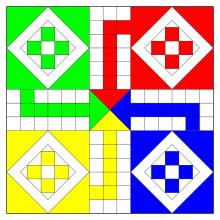Ludo
 | |
| Players | 2 - 4 |
|---|---|
| Setup time | < 5 minutes |
| Playing time | < 30 min |
| Chance | High |
| Age range | 4 and up |
| Skills | Dice rolling, right moves |
LUDO (from Latin ludo, "I play") is a simple board game, similar to Tock and Sorry!, for two to four players, in which the players race their four tokens from start to finish according to dice rolls. The game is a simplification of the traditional Indian Cross and Circle game Pachisi. The game is popular in many countries and is known as "Ludi" in the Caribbean, and "Fia" in Sweden.
History
Pachisi originated in India by the 6th century[1]. The earliest evidence of this game in India is the depiction of boards on the caves of Ajanta[1]. This game was played by the Mughal emperors of India; a notable example being that of Jalaluddin Muhammad Akbar, who played living Pachisi using girls from his harem[1]. Variations of the game made it to England during the British Raj, with one appearing under the name Ludo around 1896, which was then patented [1].
Board
A ludo board is normally a square marked with a cross. Each arm of the cross is divided into three columns, with the columns divided into usually six squares. The centre of the cross is the finishing square which is often divided into four coloured triangles. Each coloured triangle is combined with a coloured middle column appears as an arrow pointing to the finish. The shaft of each arrow is a player's "home column" and is five squares long.
To the left of each home column, one square from the edge of the board, is a starting square, also coloured. During game play a piece moves from its starting square, clockwise around the perimeter of the board, and up the player's home column to the finishing square. In the space to the left of each arm is a circle or square to hold a player's pieces before they are allowed into play. Unlike Pachisi, there are no resting squares, but the coloured home column may only be entered by its own player's tokens.
The special areas on the board are typically brightly coloured with yellow, green, red, and blue. Each player uses cardboard or plastic tokens of matching colour.
Rules
At the start of the game, the player's four pieces are placed in the start area of their colour.
Players take it in turn to throw a single die. A player must first throw a six to be able to move a piece from the starting area onto the starting square. In each subsequent turn the player moves a piece forward 1 to 6 squares as indicated by the dice. When a player throws a 6 the player may bring a new piece onto the starting square, or may choose to move a piece already in play. Any throw of a six results in another turn.
If a player cannot make a valid move they must pass the die to the next player.
If a player's piece lands on a square containing an opponent's piece, the opponent's piece is captured and returns to the starting area. A piece may not land on square that already contain a piece of the same colour (unless playing doubling rules; see below).
Once a piece has completed a circuit of the board it moves up the home column of its own colour. The player must throw the exact number to advance to the home square. The winner is the first player to get all four of their pieces onto the home square.
Variations
- To get a game started faster, some house rules, allow a player with no pieces on the board to bring their first piece into play on any roll, on a 1 or a 6, or allow multiple tries to roll a 6.
- If a piece lands on the same space as the another piece of the same colour, the moved piece must take the preceeding space.
- If a player's piece lands on another of their own pieces, they are doubled and form a "block" which cannot be passed by any opponent's pieces. Or in some variations may only be passed by rolling a 6.
- Doubled pieces may move half the number if an even number is thrown e.g. move 2 spaces if a 4 is thrown.
- A doubled piece may capture another doubled piece (like in Coppit).
- A board may have only four spaces in each "home column". All four of a player's piece must finish in these spaces for the player to have finished the game. (See Mensch ärgere dich nicht.)
- To speed the game up, extra turns or bonus moves can be awarded capturing a piece or getting a piece home; these may grant passage past a block.
In some parts of Africa the following rules are reportedly played:
- a doubled block also blocks trailing pieces of the player who created the block, or blocks them unless they roll the exact number to land on the block. This reduces the tactical advantage of a block and makes the game more interesting.
- there are 4 safety squares on the board, like castle squares in Pachisi, as well as the safe home squares, where a piece may not be captured.
- capturing an opponent's piece is compulsory and may force a piece to move onto a dangerous square.
- the game is played at high speed, with players able to move forwards or backwards and start their turn before previous player finishes. Cheating and catching others cheating is an integral part of the play.
